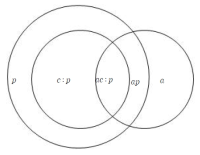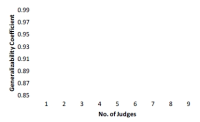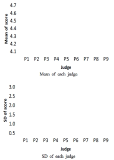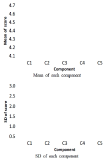
The purpose of this study was (1) to analyze judges’ evaluation on figure skating performance and statistical analysis and (2) to make recommendation to improve judges' performance. Data were 62 figure skaters’ scores from Senior Woman 1 Group Part at 2015 The National Figure Skating Championship in Korea. Data of presentation part in Short Program were analyzed. Presentation part consists of skating skills, transitions/linking footwork/movement, performance/execution, choreography/composition and interpretation. Nine judges evaluate skater's presentation with the score 10.0 for each factor. Generalizability theory, descriptive statistics and ANOVA were utilized. Results showed that generalizability coefficient of presentation part was over 0.9, therefore stable reliability was secured. The error source about players has more significant impact to evaluation than other error sources. Generalizability coefficient was stable when reducing the number of judges up to 2. Also, judges generally represented aspects of similar evaluation, but different aspects appeared on a few judges’ assessment in the components of presentation. Discussions were provided in terms of the reliability of the judging method for the presentation part of figure skating and the effective measurement condition.





Purpose The purpose of this study was to compare the technique and power of the Korean national athletes and international athletes in the start phase of the 500 m speed skating to improve the performance and to understand the relationship between the biomechanical variables affecting the record. Method The subjects were 8 Korean national athletes (Korean athletes) and 6 international athletes (international athletes). For the three dimensional motion analysis, 5 high-speed cameras were used to capture the 40 m start phase of the athletes participating in the international competition. The variables selected for analysis were the kinematic chain, 100 m net time, time to 9 strokes, horizontal position of center of mass after 2.5 sec, range of motion of trunk, knee, push-off angle, net power output, total power loss. Results The correct kinematic chain ratio of Korean athletes was 61.2%, which was lower than 76.0% of international athletes. The time to 9 strokes was 2.82±0.25 sec for Korean athletes, which was significantly lower than 2.53±0.11 sec for international athletes (p=.001). The range of motion of the push-off angle was 60.15±2.75° for Korean athletes, which was significantly lower than 64.76±2.55° for international athletes (p=.001). The net power output was 887.2±269.9 W for Korean players and 1103±264.1 W for international players (p=.021). The variables related to the 100 m net time were the horizontal position of center of mass after 2.5 sec (r=-.956, p=.001), the net power output (r=-.931, p=.001), and the total power loss (r=-.904, p=.001). Conclusion In order to improve the start performance of Korean athletes, it is necessary to maximize the efficiency of skating through skill training to use the correct kinematic chain. Also power enhancement training is needed to improve leg power because the net power output related with 100 m net time.


PURPOSE The purpose of this study was to provide information for improving the performance and skills of 500 m speed skaters by analyzing the kinematic and kinetic changes in their slide board movements over time. METHODS The subjects were 10 male short-distance skaters in their 20s to 30s who were registered as professional athletes with the Korea Sports Council. The changes in joint angle, joint moment, and joint power over time in the subjects’ slide board motion were measured and analyzed. RESULTS It was found that during phase 2 of the skater’s slide board movement, there was an increase in plantar flexion and a decrease in flexion of the lower extremity joint and extension of the knee and hip joint, with decrease in positive power of the knee joint. CONCLUSIONS The results of this study are expected to provide practical information to skating coaches and athletes by quantifying the biomechanical factors observed over time during slide board movements. In addition, this study is expected to contribute to the field of speed skating by presenting scientific training methods and proposing new analysis techniques to improve performance in the future.

[Purpose] This study was designed to explore Yuna Kim’s psychological strengths and the contextual factors, which led her to obtain the gold medal and the reflection of peak performance and preparation at the 2010 Olympics. It was hoped that by sharing the experience of one of the top athletes, other athletes would learn from her and prepare themselves better for Olympics in the future. [Methods] A case study method was applied with a qualitative approach. To obtain the purpose of the study, five in-depth interview sessions including introductory and member checking procedures were conducted. The interviews were recoded and transcribed verbatim, and content analysis was used to inductively analyse the data. [Results] The four general dimensions that were discovered in the results included Social-external Factors, Personal Traits, Coping Strategies, and Peak Performance. The social-external factors consisted of social support and attached/detached relationships while personal traits were personality traits, confidence and motivation. Coping strategies to overcome external and situational pressures were detached coping and resilience whereas peak performance was reflected on flow and the state of being mindful. [Conclusion] In conclusion, Yuna Kim’s strength was parallel with the previous research on the top athletes and other findings such as adaptive perfectionism and a sense of rivalry in the research were discussed.

PURPOSE The purpose of this study was to investigate the characteristics of field and on-ice performances of ice-hockey players and the relationship of performance with subjective joint pain and dysfunction. METHODS A total of 25 male college icehockey players were evaluated for 19 items of performance. Pain and dysfunctions in the lower extremities and lower back were confirmed through the Foot and Ankle Outcome Score, Knee Injury and Osteoarthritis Outcome Score, Hip Dysfunction and Osteoarthritis Outcome Score, and Osweatry Disability Index questionnaire. Players with similar performance characteristics were classified through a cluster analysis, and differences in performance and patient-reported outcomes between clusters were analyzed with a one-way analysis of variance. RESULTS The ice-hockey players were classified into “lower muscular strength and performance (cluster 1),” “lower cardiorespiratory endurance (cluster 2),” and “high muscular strength and performance (cluster 3).” Players in cluster 1 had more frequent ankle and knee joint dysfunctions and pain compared to those in cluster 3. Several performance test items affected the subjective joint score, and the related performance items were more in the proximal joint than in the distal joint. CONCLUSIONS Ice hockey players should perform training to supplement their individual lack of on-ice and field performance. Since performance may be limited because of joint dysfunction and pain, a joint-specific intervention strategy should be applied to improve physical and athletic performances.
Purpose This study aims to explore the association between the awareness of naturalized players and the awareness of recruiting naturalized players for national players among sport fans. Methods Survey was conducted among 1,050 fans in professional sport, amateur sport, sport cafes at portal website among which 928 papers were used for final analysis. Collected data was processed by using SPSS 21.0 program. T-test, one-way ANOVA, correction analysis and multiple regression analysis were conducted to test hypothesis. Results Gender, age, household, and field income showed significant differences in the awareness of achievement among the awareness of naturalized players by fans. Age, school, and field revealed significant differences in the awareness of attitude. Age, school, household income, and field showed remarkable differences in the awareness of field and age and household income showed critical differences in the ascription awareness. Negative awareness showed that gender, age, school, and income were significantly different and the tolerable awareness showed that age, school, household income, and field revealed significantly different among the awareness of recruiting naturalized players for national players. Achievement, attitude, and ascription factors had positive impacts, while field factors had negative impacts in terms of the influence on negative awareness among the awareness recruiting foreign players for national players. In terms of the influence on the tolerable awareness, achievement, attitude, and field affected positively. Conclusions This study demonstrated that fans need to be aware of trust and assurance on achievement, attitude, and field factors of players to induce the recruitment of naturalized players for national players in a tolerable way.